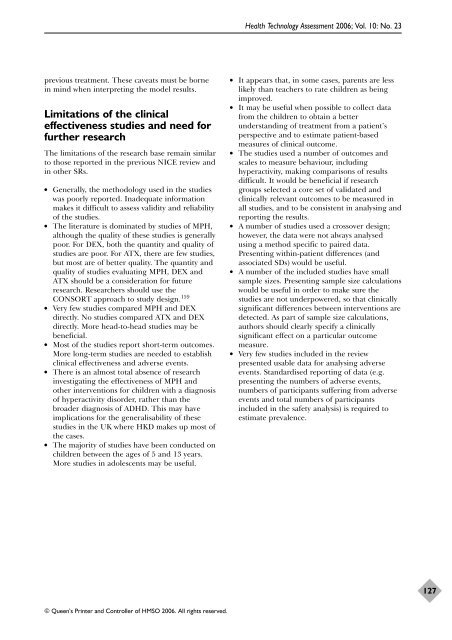A systematic review and economic model of the effectiveness and ...
A systematic review and economic model of the effectiveness and ...
A systematic review and economic model of the effectiveness and ...
Create successful ePaper yourself
Turn your PDF publications into a flip-book with our unique Google optimized e-Paper software.
previous treatment. These caveats must be borne<br />
in mind when interpreting <strong>the</strong> <strong>model</strong> results.<br />
Limitations <strong>of</strong> <strong>the</strong> clinical<br />
<strong>effectiveness</strong> studies <strong>and</strong> need for<br />
fur<strong>the</strong>r research<br />
The limitations <strong>of</strong> <strong>the</strong> research base remain similar<br />
to those reported in <strong>the</strong> previous NICE <strong>review</strong> <strong>and</strong><br />
in o<strong>the</strong>r SRs.<br />
● Generally, <strong>the</strong> methodology used in <strong>the</strong> studies<br />
was poorly reported. Inadequate information<br />
makes it difficult to assess validity <strong>and</strong> reliability<br />
<strong>of</strong> <strong>the</strong> studies.<br />
● The literature is dominated by studies <strong>of</strong> MPH,<br />
although <strong>the</strong> quality <strong>of</strong> <strong>the</strong>se studies is generally<br />
poor. For DEX, both <strong>the</strong> quantity <strong>and</strong> quality <strong>of</strong><br />
studies are poor. For ATX, <strong>the</strong>re are few studies,<br />
but most are <strong>of</strong> better quality. The quantity <strong>and</strong><br />
quality <strong>of</strong> studies evaluating MPH, DEX <strong>and</strong><br />
ATX should be a consideration for future<br />
research. Researchers should use <strong>the</strong><br />
CONSORT approach to study design. 159<br />
● Very few studies compared MPH <strong>and</strong> DEX<br />
directly. No studies compared ATX <strong>and</strong> DEX<br />
directly. More head-to-head studies may be<br />
beneficial.<br />
● Most <strong>of</strong> <strong>the</strong> studies report short-term outcomes.<br />
More long-term studies are needed to establish<br />
clinical <strong>effectiveness</strong> <strong>and</strong> adverse events.<br />
● There is an almost total absence <strong>of</strong> research<br />
investigating <strong>the</strong> <strong>effectiveness</strong> <strong>of</strong> MPH <strong>and</strong><br />
o<strong>the</strong>r interventions for children with a diagnosis<br />
<strong>of</strong> hyperactivity disorder, ra<strong>the</strong>r than <strong>the</strong><br />
broader diagnosis <strong>of</strong> ADHD. This may have<br />
implications for <strong>the</strong> generalisability <strong>of</strong> <strong>the</strong>se<br />
studies in <strong>the</strong> UK where HKD makes up most <strong>of</strong><br />
<strong>the</strong> cases.<br />
● The majority <strong>of</strong> studies have been conducted on<br />
children between <strong>the</strong> ages <strong>of</strong> 5 <strong>and</strong> 13 years.<br />
More studies in adolescents may be useful.<br />
© Queen’s Printer <strong>and</strong> Controller <strong>of</strong> HMSO 2006. All rights reserved.<br />
Health Technology Assessment 2006; Vol. 10: No. 23<br />
● It appears that, in some cases, parents are less<br />
likely than teachers to rate children as being<br />
improved.<br />
● It may be useful when possible to collect data<br />
from <strong>the</strong> children to obtain a better<br />
underst<strong>and</strong>ing <strong>of</strong> treatment from a patient’s<br />
perspective <strong>and</strong> to estimate patient-based<br />
measures <strong>of</strong> clinical outcome.<br />
● The studies used a number <strong>of</strong> outcomes <strong>and</strong><br />
scales to measure behaviour, including<br />
hyperactivity, making comparisons <strong>of</strong> results<br />
difficult. It would be beneficial if research<br />
groups selected a core set <strong>of</strong> validated <strong>and</strong><br />
clinically relevant outcomes to be measured in<br />
all studies, <strong>and</strong> to be consistent in analysing <strong>and</strong><br />
reporting <strong>the</strong> results.<br />
● A number <strong>of</strong> studies used a crossover design;<br />
however, <strong>the</strong> data were not always analysed<br />
using a method specific to paired data.<br />
Presenting within-patient differences (<strong>and</strong><br />
associated SDs) would be useful.<br />
● A number <strong>of</strong> <strong>the</strong> included studies have small<br />
sample sizes. Presenting sample size calculations<br />
would be useful in order to make sure <strong>the</strong><br />
studies are not underpowered, so that clinically<br />
significant differences between interventions are<br />
detected. As part <strong>of</strong> sample size calculations,<br />
authors should clearly specify a clinically<br />
significant effect on a particular outcome<br />
measure.<br />
● Very few studies included in <strong>the</strong> <strong>review</strong><br />
presented usable data for analysing adverse<br />
events. St<strong>and</strong>ardised reporting <strong>of</strong> data (e.g.<br />
presenting <strong>the</strong> numbers <strong>of</strong> adverse events,<br />
numbers <strong>of</strong> participants suffering from adverse<br />
events <strong>and</strong> total numbers <strong>of</strong> participants<br />
included in <strong>the</strong> safety analysis) is required to<br />
estimate prevalence.<br />
127
















